Architecture of Nubia
Ancient Nubia took after ancient Egypt in so many respects, and if they could do it in art, then architecture was certainly no exception. The following are temples and other buildings from ancient Nubia, some remarkably preserved, others unfortunately not so.
Abu Simbel
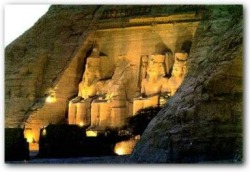
Probably one of the best-known ancient Egyptian temples, if not the best-known. The temple of Ramses II, as well as the temple of Nefertari dedicated to Hathor, these temples stood for a thousand or so years, until a problem arose in the 1960s. These temples were threatened with submersion bythe rising waters of Lake Nasser, which was made by building the Aswan Dam. So, the Egyptian government got help in an international effort to cut up both temples into blocks, locate them to higher ground, and then rebuild them, 60 meters higher than their original positions, but nevertheless still aligned as they were originally intended and built. (More information can be found here.)
Kalabsha Temple
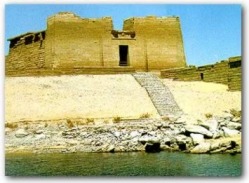
This temple was moved to New Kalabsha during the salvage operation, and is the largest freestanding Egyptian temple in Nubia. It was built by Agustus Ceasar (27 BC - 24 AD) and dedicated to Osiris, Isis and Mandulis. The half finished column capitals, and fragments of relief decorations of the temple provide considerable insight about ancient Egyptian construction and carving techniques. (More information can be found here.)
Beit al-Wali
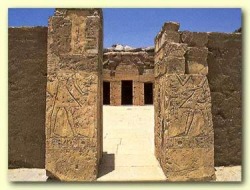
Connected by a path to the Roman-era Kalabsha temple is the older Beit al-Wadi temple ("the House of the Holy Man") that was also moved to New Kalabsha. This small rock-cut temple was originally fronted by a mud-brick pylon which was not moved, and consisted of an entrance hall, a hypostyle hall and a sanctuary. It is a delightful temple with painted decorations in reds, blues and greens that retain most of their original brilliance. In the entrance to the temple scenes of Ramesses II show him smiting his enemies, often accompanied by his pet lion. In the sanctuary are seated statues of Ramesses II and deities such as Horus, Isis and Khnum. (More information can be found here.)
Kiosk of Qertassi
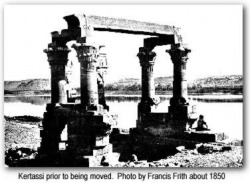
To the south of the Kalabsha Temple near Aswan is the light, almost delicate Kiosk of Qertassi (Kertassi), with its two Hathor-headed columns, was moved at the same time and now stands near the water commanding fine views of Lake Nasser. (More information can be found here.)
Gerf Hussein
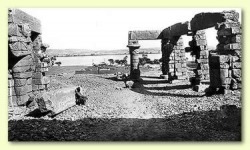
Unfortunately, the remains of this temple are very fragmentary. It was built by Setau who, was a viceroy of Kush during Ramesses II's reign. This temple was originally a combination rock-cut and freestanding temple similar to Abu Simbel, and it was dedicated to Ramesses II, Ptah, and Ptah-Tatenen (a Nubian-Egyptian creator god). Gods were carved out of the rock in the sanctuary, like at Abu Simbel. (More information can be found here.)
The Temple of Dakka
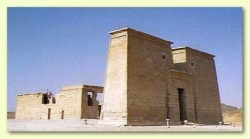
This is the Temple of Dakka, a Ptolemaic temple originally situated forty miles north of its present location. Built using fragments of an older 18th Dynasty temple (possibly built by an Ethiopian king Arkamani), it was dedicated to Thoth of the Sycamore Fig. The axis of the temple runs parallel with what was once the river. (More information can be found here.)
The Temple of Wadi al-Sabua
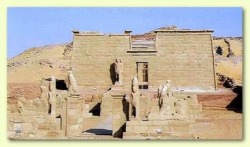
Just south of the Dakka Temple is Wadi as-Subua (Wadi es-Sebua) where two temples are located. It is known as the Valley of the Lions because of the sphinxes that once lined the avenue leading to the first temple. It was constructed by Amenhotep III and added to by Ramesses II. Unfortunately, most of the decorations were defaced by early Christians. The front is free standing and the rear was rock-cut. This temple consists of a sanctuary, a court, a hall and pylons. It was originally dedicated to the Nubian version of Horus, but was later rededicated to Amun-Re. (More information can be found here.)
The Temple of Amada
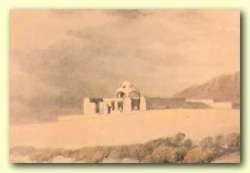
The next temple is Amada, the oldest of the temples, going back to the 18th dynast with restoration work from the 19th dynasty. Tuthmosis III, Amenhotep II, and Tuthmosis IV were all involved with its construction, and Seti I restored sections of it. The fine preservation of the temple is due to Christians plastering over the reliefs. The temple, dedicated to Amun-Re and Re-Harakhte, contains an inscription relating the crushing of a Libyan-backed rebellion by King Merneptah (1212-1202 BC). At the back of the temple inscriptions tell about the famous wars in Syria of Amenhotep II’s and how he bought back the bodies of rebel chieftains to hang on the walls of Thebes. One body was hung from the prow of his ship sailing through Nubia as a warning. This temple was moved about two kilometers (one mile) from its original site. (More information can be found here.)
The Temple of Derr
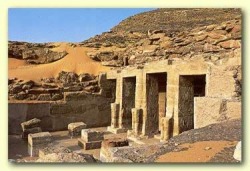
Nearby is the temple of Derr, built by Ramesses II and dedicated to himself, Amun-Re, Re-Harakhte and Ptah. This rock-cut temple is well decorated with bright, visible colors and was moved from near the Amada temple in 1964. There is also the tomb of Pennut here that originally stood at Aniba. Pennut was an administrator in Nubia during the reign of Ramesses VI and is shown receiving honors from him in this rock-cut tomb. However, large sections of wall inscriptions have been cut away. (More information can be found here.)
Qasr Ibrim
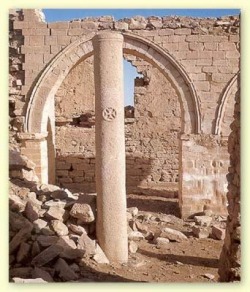
The last site before Abu Simbel is a large, mostly flooded island at Qasr Ibrim. It once housed as many as six temples and a Roman era fort, encompassing an expanse of historic periods including the pharaonic, Roman, Christian and Arab/Nubian eras. It was the last bastion of paganism in Nubia. Tourists could once visit the site, but damage by boats and foot traffic in the mostly mudbrick ruins have led to the Egypt Exploration Society convincing the Antiquities Council to bar tourists from the site. Boats still stop for a look however. At one time prior to the rise of Lake Nasser, it could be visited by a land bridge. (More information can be found here.)
